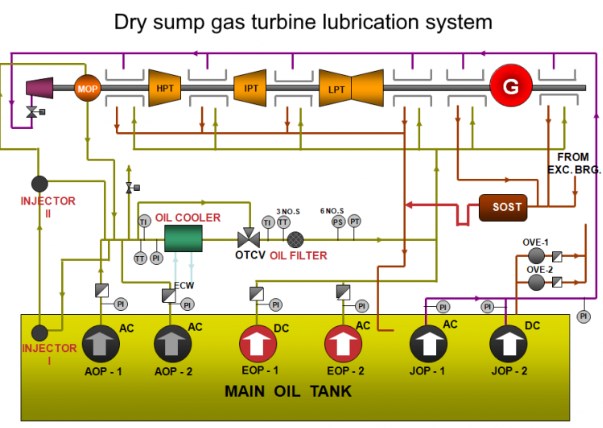How Engine Lubrication System Works?

The engine oil is stored in the oil pan. When the engine starts to run, the driven oil pump rotates. Because the oil pump has the function of self-priming, it can suck the oil from the oil pan through the collecting filter, and establish a certain pressure to send it into the oil filter. In order to prevent the oil pressure from being too high during cold start, high oil viscosity, and high engine speed operation, a pressure limiting valve is usually installed on the oil pump. When the oil pressure exceeds a certain value (usually 0.8MPa), the pressure limiting valve opens to drain the excess oil directly into the oil pan. The flow of the oil pump is generally between 10 and 40 liters/minute. For most engines, the oil can be circulated in the engine within 30 seconds.
After the oil with certain pressure comes out of the oil pump, if it is full-flow filtration, the oil will all enter the oil filter; If it is a split filter, about 10% of the oil will enter the secondary oil filter. In order to ensure that the oil pressure in the main oil gallery is normal and prevent the oil from being diverted when the oil pressure is too low, an oil inlet pressure limiting valve is set in front of the oil fine filter. Only when the oil pressure exceeds 0.1MPa, the oil can open the pressure limiting valve and enter the oil fine filter. After the oil with certain pressure enters the oil fine filter, it will be sprayed out from two small nozzles. The resulting reverse force will drive the fine filter to rotate at high speed (up to 10000 rpm), driving the oil to rotate at high speed. The centrifugal force will throw the impurities in the oil onto the inner wall of the fine filter housing and precipitate. The filtered clean oil will flow directly back to the oil pan from the oil outlet. In order to prevent the blockage of the secondary oil filter from causing abnormal oil pressure, a bypass valve is also set. When the pressure exceeds 0.6MPa, it opens, and the oil directly flows back to the oil pan from the bypass valve. The secondary oil filter has a slight "buzzing" sound when it works, which will last for several seconds after the engine stops. This is also one of the methods to judge whether it works normally.
For most automotive engines, full-flow filtration is adopted. After the oil with certain pressure comes out of the oil pump, the oil will all enter the oil filter, and enter from the small holes around the filter element. After being filtered by the filter paper, impurities and colloid will remain on the surface of the filter paper. Clean oil will enter the middle of the filter element and flow out of the oil outlet, and enter the main oil channel. There are two very important valves in the oil filter: bypass valve and check valve. When the oil filter element is blocked, the bypass valve opens, and the oil enters the main oil passage without filtering through the filter paper; The check valve is to prevent the oil from flowing back to the oil pan after the engine is stopped, to ensure that the oil pressure is directly formed after the engine is started, and to minimize the time of dry friction of the engine. The opening pressure of these two valves is accurately calculated. If inferior oil filters are used, the quality of these two valves is poor, and the filtering effect of filter paper is poor, which will seriously affect the filtering effect of oil.
If a water-cooled oil radiator is installed, the oil will directly enter the oil radiator after coming out of the filter, and then flow into the main oil gallery after being cooled by the engine coolant. In order to avoid the insufficient oil supply caused by the blockage of the oil radiator and to prevent the oil radiator from being damaged by excessive oil pressure, a bypass valve is set on the oil radiator. When the oil pressure is higher than 0.4MPa, the bypass valve opens and the oil directly enters the main oil passage.
The oil entering the main oil duct has a certain pressure, which is the so-called "oil pressure", which is generally between 0.2 and 0.5Mpa. The oil pressure sensor is installed here to convert the oil pressure value into an electrical signal and transmit it to the instrument panel for the driver's reference. Generally, on trucks or construction machinery, oil pressure gauge is used to display the oil pressure; The oil pressure warning lamp is more used in passenger cars. If the engine oil pressure is too low, it will cause poor lubrication and aggravate the wear of parts; If the oil pressure is too high, it will lead to difficult sealing of the engine, oil seal leakage and increased oil consumption.
In the main oil passage, the oil will flow in different directions according to the engine structure, such as crankshaft main bearing, connecting rod bearing, piston oil nozzle, camshaft, valve rocker arm, hydraulic valve tappet, timing gear, timing chain, supercharger, air pump, fuel injection pump, variable valve timing mechanism, timing chain tensioner, etc., which are described below.
1.Main oil passage → crankshaft main bearing, connecting rod bearing: oil enters the crankshaft main bearing from the branch on the main oil passage. Generally, the crankshaft has several supports, and there are several branch oil passages. For example, four-cylinder engines generally have five branch oil passages, and six-cylinder engines generally have seven branch oil passages. There is a corresponding hole on the main bearing of the crankshaft, from which the oil enters between the main bearing and the crankshaft to lubricate the friction pair. The excess oil flows out from the gap between the main bearing and the crankshaft and directly returns to the oil pan. A part of the oil from the crankshaft main bearing flows into the connecting rod bearing through the oil passage inside the crankshaft to lubricate the connecting rod bearing and the connecting rod journal. The excess oil also flows out from the gap between the two and returns to the oil pan. For the lower camshaft, a part of the oil flows into the camshaft bearing from the crankshaft main bearing to lubricate the friction pair between the camshaft and the cylinder block. The excess oil flows out from the overflow hole on the camshaft journal and returns to the oil pan under the action of gravity. These parts belong to pressure lubrication, and most of the engine oil is used in these parts. When the friction pair clearance of these parts increases, the oil leakage will increase, and the engine oil pressure will decrease, which generally requires overhaul.
2.Main oil passage → piston oil nozzle: now many highly intensified engines have higher combustion chamber temperature and higher piston temperature, so special devices are needed to cool the piston, which is completed by the piston oil nozzle. An oil nozzle is installed at the position of the main oil passage corresponding to each cylinder. When the pressure of the main oil passage exceeds 0.1MPa, the valve on the oil nozzle opens, and the oil with certain pressure is directly sprayed to the bottom of the piston to cool the piston. A small part of the spilled oil is used to lubricate the piston pin and cylinder wall, and the rest falls back to the oil pan.
3.Main oil passage → overhead camshaft, valve rocker arm, valve, etc.: The oil is separated from the main oil passage upward and directly reaches the cylinder head, and then enters between the camshaft journal and the cylinder head, between the valve rocker arm and the rocker arm shaft. The pressure lubricates these parts. The excess oil flows out from the gap of these friction pairs, and is driven by the high-speed rotating camshaft to splash around to lubricate the valve rocker arm and valve stem, valve spring, etc, Finally, the oil flows back to the oil pan from the oil passage on the cylinder head. In order to avoid oil backflow after engine shutdown, there is a check valve at the oil passage port to keep the cylinder head part at a certain oil pressure.
4.Main oil passage → timing gear, timing chain, supercharger, air pump, fuel injection pump, etc.: these parts all need special lubrication, so special lubricating oil passage or oil nozzle are generally set separately to introduce oil, and the lubricated oil flows back to the oil pan under the action of gravity. The supercharger lubrication is particularly important here. Because the supercharger rotor speed is very high and the operating temperature is very high, the oil flow and pressure required are large, and the corresponding oil pipeline is relatively thick.
5.Main oil passage → hydraulic valve tappet, variable valve timing mechanism, timing chain tensioner: these devices belong to the hydraulic servo mechanism of the engine, and the oil will maintain a certain pressure inside them, which is often closed operation, and there is less circulating communication with the lubrication system. When adjusting the internal pressure, the excess oil flows out directly and returns to the oil pan along the fixed oil passage.
Engine Lubrication System Works Vedio
Almost all parts of the oil flow directly into the oil pan after lubrication, and then it is re-injected into the oil pump to participate in the next cycle. Generally, the oil will circulate once every half minute in the engine, which should be said to be very efficient.





















